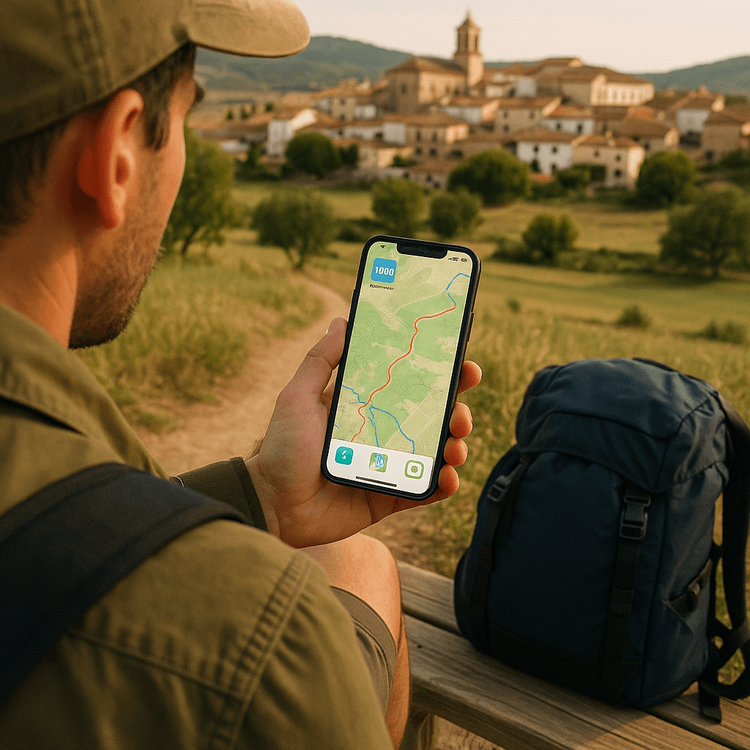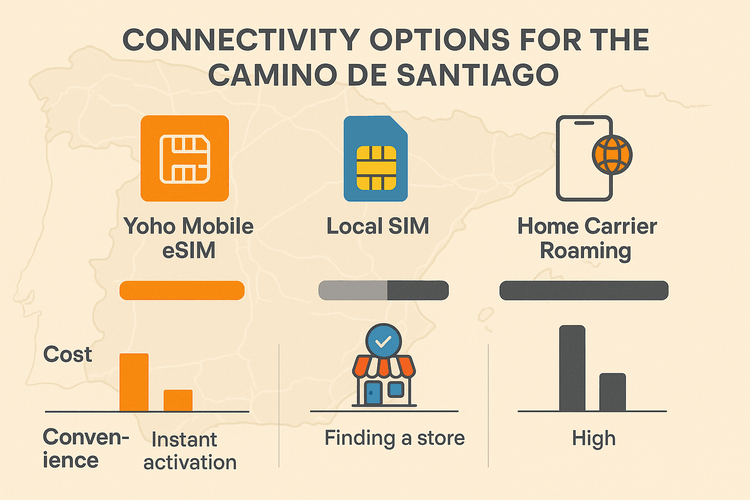Embarking on the Camino de Santiago is a journey of a lifetime. For centuries, pilgrims have walked these ancient paths across Spain for spiritual reflection, personal challenge, and profound connection. In the digital age, a new companion has joined the scallop shell and hiking poles: the smartphone. But how do you ensure this tool enhances your pilgrimage rather than complicates it? The answer lies in seamless, hassle-free connectivity.
Staying connected is no longer a luxury on the trail; it’s a key part of modern pilgrimage safety and logistics. From navigating a detour to booking your next albergue, reliable data is crucial. This guide, built on the experience of past pilgrims, will show you how to stay connected effortlessly with an eSIM. Before you take your first step, ensure your digital journey is sorted. Explore Yoho Mobile’s Spain eSIM plans and walk with peace of mind.
Why Connectivity Matters on The Way of St. James
While the Camino is an escape, smart connectivity can significantly improve the experience. It’s not about staying glued to your screen, but about having a reliable tool when you need it most.
- Navigation: While the yellow arrows are iconic, trails can sometimes be unclear, especially when leaving towns or in bad weather. A quick check on Google Maps or a dedicated Camino app can save you from a long, frustrating detour. Reliable data ensures your digital compass is always available.
- Safety and Peace of Mind: Informing family you’ve arrived safely at your destination, checking urgent weather alerts before tackling a mountain pass, or having the ability to call for help are all critical safety aspects. Pilgrimage connectivity gives you and your loved ones peace of mind.
- Logistics and Community: The Camino thrives on its community. A data connection lets you book a bed in the next town’s albergue, which can be essential during busy seasons. It also helps you coordinate with fellow pilgrims you meet along The Way.
- Capturing Memories: Instantly sharing a photo of a stunning sunrise over the Meseta or video-calling family from the steps of the Santiago de Compostela Cathedral makes the journey more memorable.

Understanding Network Coverage Along the Camino
The Camino de Santiago stretches over hundreds of kilometers, crossing bustling cities and remote countryside. So, what is the mobile phone coverage like on the Camino Francés and other routes?
Generally, Spain has excellent mobile infrastructure. In cities and large towns like Pamplona, Burgos, and León, you’ll find strong 4G and even 5G signals. However, as you venture into more rural areas—the vast plains of the Meseta or the green hills of Galicia—coverage can become less consistent.
Different local carriers like Movistar, Orange, and Vodafone have varying strengths in different regions. This is where an eSIM from a provider like Yoho Mobile shines. Our eSIMs connect to the strongest available local network, ensuring you have the best possible signal wherever your feet take you, maximizing your chances of having a stable connection for that crucial albergue booking.
Your Connectivity Options: eSIM vs. Local SIM vs. Roaming
When hiking in Spain, you have three main choices for staying connected. Let’s break down which is the best data plan for the Camino de Santiago.

-
Yoho Mobile eSIM (The Smart Pilgrim’s Choice): An eSIM (embedded SIM) is a digital SIM card. You can buy and install it before you even leave home. There’s no tiny piece of plastic to lose, and activation is instant. For iOS users, it’s even simpler—just a single tap to install after purchase, no QR codes needed. This is the ultimate in convenience for a long-distance trek.
-
Local Physical SIM: This involves finding a mobile phone shop upon arrival in Spain, dealing with potential language barriers, and going through a registration process that often requires your passport. It’s a hassle that takes away from the precious start of your pilgrimage.
-
International Roaming: Using your home carrier’s roaming plan is often the most expensive option. Daily charges can add up quickly over a 30-day walk, leading to a shocking bill when you return home. It’s an unreliable and costly way to manage your long distance trek data needs.
Here’s a quick comparison:

Ready to make the smart choice? Get your Spain eSIM from Yoho Mobile today and walk with confidence and connectivity.
Choosing the Best eSIM for Your Camino Journey
Not all eSIMs are created equal. Here’s what to look for when choosing your digital travel companion:
-
Sufficient Data: How much data do you need? For a 30-day walk, a plan with 10-20GB is usually sufficient for maps, messaging, social media, and booking accommodations. If you plan to stream videos, consider a larger plan.
-
Flexible Duration: Choose a provider that offers plans matching the length of your trip, whether it’s a 10-day section or the full 35-day pilgrimage. With Yoho Mobile, you can build your own flexible plan tailored to your exact needs.
-
Reliability and Support: The last thing you want is to run out of data in the middle of nowhere. Yoho Mobile offers Yoho Care, a unique safety net that provides you with backup data access to stay connected for essential tasks even if your main plan expires. You can then perform a manual top-up whenever you’re ready. Learn more about how Yoho Care has your back.
-
Device Compatibility: Most modern smartphones support eSIM technology, but it’s always best to check. You can verify your device on our official eSIM compatible phone list.
Frequently Asked Questions (FAQ)
Q1: Can I use an eSIM on the Camino de Santiago?
Absolutely. An eSIM is the ideal solution for the Camino. It’s lightweight (zero physical weight), easy to install before you leave, and provides reliable connectivity by connecting to the best local networks in Spain. It’s the most modern and hassle-free way for any pilgrim to stay connected.
Q2: How do I activate my Yoho Mobile eSIM for Spain?
Activating an eSIM for your travel in Spain is incredibly simple. After purchasing, you’ll receive instructions. For iPhone users, our one-click installation takes you directly to your phone’s settings to add the eSIM in under a minute—no QR code scanning required. Android users can quickly scan the provided QR code to install their plan.
Q3: What happens if I run out of data while hiking in Spain?
With Yoho Mobile, you’re never truly disconnected. If you use up your data, our Yoho Care service ensures you maintain a basic connection for essential apps like WhatsApp or Maps. You can then easily log in to your account and manually top up your data plan to get back to full speed.
Q4: Will my phone work on the Camino?
Most likely, yes, provided it is ‘unlocked’ (not tied to a single carrier) and supports eSIM. Most smartphones made in the last few years are compatible. We recommend checking our comprehensive eSIM compatibility list to be certain before your purchase.
Buen Camino: Walk Connected and Confident
The Camino de Santiago is a journey that will stay with you forever. It’s a chance to disconnect from the noise of daily life and reconnect with yourself. By choosing the right tools, like a reliable eSIM, you can eliminate the stress of modern travel logistics and focus on the path ahead.
A Yoho Mobile eSIM provides the perfect balance of connectivity and freedom. It’s a simple, affordable, and powerful tool that works quietly in the background, ready for when you need it most.
Embark on your pilgrimage with complete peace of mind. Not sure if it’s for you? Try our free eSIM trial and experience the convenience for yourself. Buen Camino!
